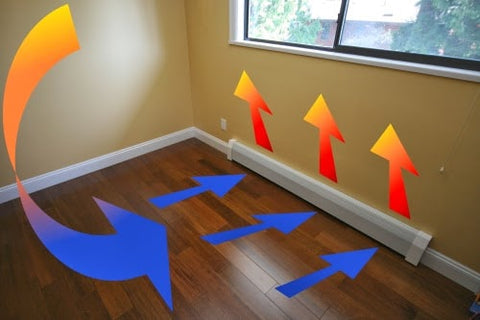Convection Heating

When you are the leader in an industry, you should be expected to have a sound technical background to compliment great customer service. Baseboard heater covers involve covering over a device that is manufactured by others and must function correctly with any add-on accessories. This post will help explain how baseboard heaters work and why anything that covers them must be properly designed to allow the finned tube heating elements to function with optimal performance.
Convection Heating
Convection air current heating has been around for a long time, here's how it works. Air is constantly moving around the walls, floors and ceilings in every room in your home. These gentle air currents become a handy transport vehicle for heat distribution when baseboard heating is employed. With reference to the above graphic, the movement of heated air is "powered" by the baseboard heater. Cool air hovering near the floor comes into contact with the baseboard heater cover and the heating element itself. This air current is then heated and propelled up to the ceiling. Eventually this heated air near the ceiling cools and slowly drops down again to the floor, repeating the circular process known as convection air current heating. Pretty simple stuff.
Using a Baseboard Heater Cover
Our company has run numerous tests to find out how baseboard heaters perform when objects are put directly over top of them. Among our findings comes an interesting fact that if you want to maximize the efficiency of your heaters, do not install any cover at all. Just bare naked finned tube element. Of course this isn't a good idea from an aesthetic and safety perspective. So assuming a cover will be used, the first and most important consideration is one that will promote excellent air flow. If the convection air currents cannot easily travel around the element, forget about any decent heat output. Our baseboard heater covers are full of 1/8″ diameter holes which ensures a near zero restriction from top to bottom. This design elegantly combines an attractive look while ensuring proper air flow even with high pile carpets. The other important factor in proper baseboard heating is the covers ability to hold heat energy. Why is this? - because they can also act as an extension of the heating element. Convection air currents will come into direct contact with the cover and if the cover is hot the air currents will be able to grab this heat energy. Baseboard heater covers made of materials that do not hold heat energy like (plastic for example) will significantly reduce the heater's efficiency and will take much longer to heat a volume of interior space. The transfer of energy involved in the baseboard heating process is as follows:
Fuel (gas, oil) >> Heated Water >> Heated Copper Pipe >> Heated Element/Cover >> Heated Air
There are a number of things home owners can do to ensure great heating performance from their baseboard heaters:
- Vaccuum out the finned tube elements at the beginning of the heating season.
- Straighten out any fins that appear bent.
- Ensure you have at least one full inch between the finished floor and the bottom of the finned tube element.
- Understand how to use the damper (pivoting part near the top of the heater). The damper is designed to either enable or disable air flow around the element.
- If you have a technical question about convection heating, please contact us.
